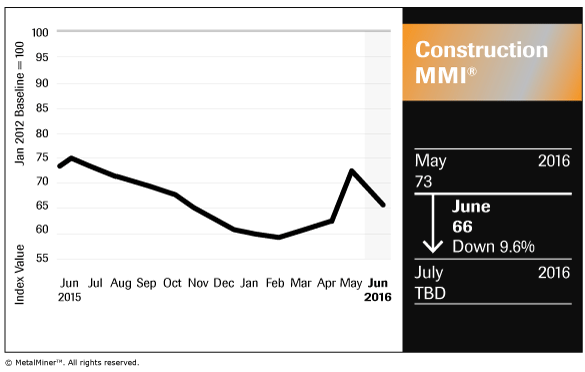The U.S. Census Bureau reports that construction spending fell 1.8% in April compared to the previous month. It rose 4.5% compared to April 2015. Construction spending in the first four months of 2016 is still 8.7% higher than for the same period one year ago.
Commercial construction spending fell 3.7% to $72.0 billion, but remains 6.8% above April of 2015. Educational construction spending was down 2.4% to $88.4 billion, still 5.4% greater than April a year ago. Manufacturing construction dropped 1.4% to $76.3 billion, 9.8% below April, 2015.
Labor Still in Demand
Our Construction MMI for June was no outlier, falling 9.6% to 66 from 73 in May. As we noted in May, a lack of skilled labor continues to plague U.S. construction. Overall job creation was up 2% in the U.S. between March and April, but it was up 4.7% for the construction industry and 2.5% for the architectural and engineering services sector. Those are healthy increases, but many projects still need skilled laborers who are in short supply and, despite increasing spending and decent demand for new homes and commercial construction, many projects are idled while waiting for crews.

Nine out of 10 contractors (89%) say they are having trouble filling open positions, according to a 2015 survey conducted by the Associated General Contractors of America. The shortages are most acute among skilled, and generally well-paid, craft workers such as carpenters, electricians, sheet-metal and concrete installers, as well as among construction managers and supervisors.
That’s why it was so odd for investment bank Goldman Sachs (NYSE:GS) to note that “labor shortages may not be to blame” for what it called a spate of mediocre construction activity. All of the surveys we’ve seen beg to differ.
Metals Corrected in May
All of the constituent elements of our construction sub-index save scrap and fuel surcharges fell this month, as the construction metals felt the pinch of a broad correction that affected nearly every metals market in May. The U.S. dollar unexpectedly strengthened last month as talk of more Federal Reserve interest rate increases than expected coming this year took hold.
The macro factors that caused raw steels, copper and aluminum to fall this month were acutely felt in construction markets. Ratings agency Moody’s also said this week, in a China Daily report, that it expects the massive Chinese construction industry to continue to experience sluggish growth for the rest of this year and much of next.
“The industry will see low-single-digit revenue increase, similar to the 2% recorded in 2015 and down from 8.7% in 2014,” said Lu Chenyi, a Moody’s vice president and senior analyst, citing construction companies’ large order backlogs and long lead times for project completion.
The construction of both residential and commercial buildings will likely be sluggish during the coming 12 to 18 months due to the economic slowdown, moderating property-sales growth and high level of developed but unsold properties in lower-tier cities, Lu said.
The U.S. market will likely recover from its drop this month, but we can’t really expect double-digit growth here at home, either, with the labor situation. So it would appear that, at least in the world’s largest markets, tepid growth is the best that can be expected.
by Jeff Yoders
